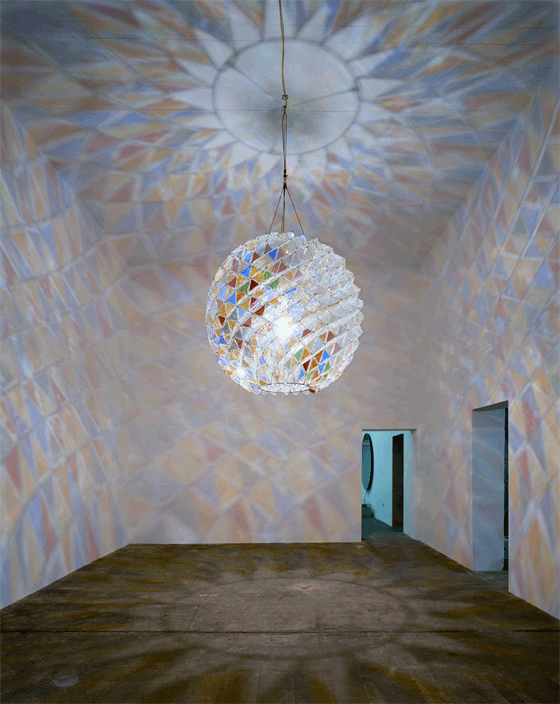Christian Boros interview: I collect art that I don’t understand (2009)
To what extent does his expertise in communications affect his interest in art?
Art Design Publicity at ADC | 18 November 2009 | Co-partner: Sculpture magazine.
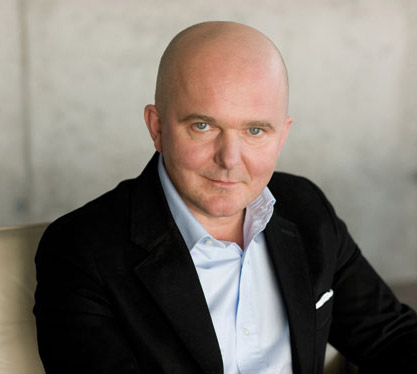
Christian Boros photo. © Oliver Mark.
Christian Boros interview
It’s certainly an unusual event when a former WWII bunker gets transformed into an art exhibition space, but such is the case in Berlin, Germany. The site that once protected 2,000 civilians, built in 1943, has been transformed into a five story, 3,000 sq m exhibition space for the private art collection of a self-made communications agency entrepreneur, Christian Boros. Featuring a rotating display of the 500 works in the collection, around 80 works have been on view by artists such as Anselm Reyle, Olafur Eliasson, Santiago Sierra, Sarah Lucas, Wolfgang Tillmans, and Rirkrit Tiravanija, with works often purchased early on in the artists’ careers before their prices have risen. Sculpture and installation feature prominently in the display. The site has been open to the public, by appointment only, since June 2008.
The former bunker, purchased by Christian Boros in 2003, is in addition to being a listed building, an unusual site for contemporary art. One hundred and twenty original rooms with 2.3-meter-high ceilings have been shaped into 80 spaces, some with 13-meters ceilings. The redesign was not an easy task, given that the reinforced concrete walls were two meters thick, with 3m-thick ceilings, in this building which has no daylight. Atop the original bunker is an approximately 4,800 sqare foot penthouse for Boros and his family, which is used as a weekend residence for the advertising entrepreneur, whose agency is based in Wuppertal, western Germany.
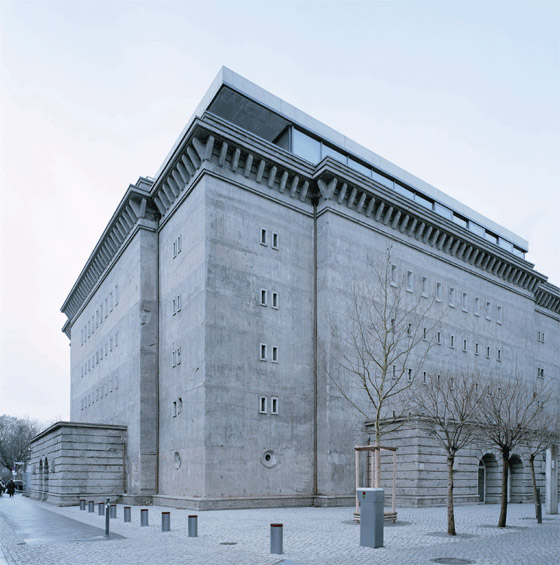
Boros Collection, Berlin.
R. J. Preece: You put a quote on your website "I collect art that I don’t understand.” Could you explain what you mean by that statement?
Christian Boros: I collect art that irritates me. This is not meant as a kind of rejection. It is rather the wish I have, that a work of art changes the limits of my thinking so my perception shifts. This is the only way I can develop myself.
R. J. Preece: Could you explain what you mean, with regard to Anselm Reyle’s Life Enigma (2008)?
Christian Boros: I like artists that make it difficult for me at first. Artists that challenge me, question my conventions and show me something new. So, for example, with the Anselm Reyle: I find the work provocative in its use of color. He let this bronze work be painted by a company that usually paints Harley Davidson motorcycles. With the glitter, he’s working against good taste. You cannot really like works by Reyle without having concerns. There is always something evil, irritating in his works.
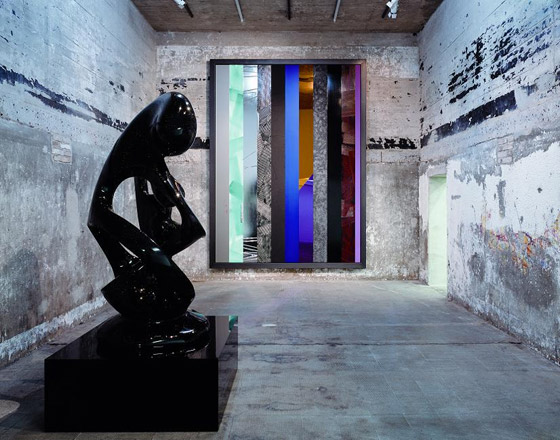
Anselm Reyle. Life Enigma, (2008). Bronze with motorcycle paint, 230 x 100 x 100 cm. Also, Untitled, (2008) (background, right). Boros Collection, Berlin.
R. J. Preece: Would you describe your approach to selecting works as instinctual, emotive, or even subjective versus analytical?
Christian Boros: Correct. These approaches are important in my selections. They apply to the two kinds of works that I collect, abstract works and very emotional ones.
R. J. Preece: Would you say that your business-communications sensibilities and eye for that are also comparable to your art selections?
Christian Boros: Absolutely. As an advertising man an artistic perspective is as important as the rationality of the art collector.
R. J. Preece: How does your eye for communications add value to your eye for art? Or do you try to separate them?
Christian Boros: I don’t separate the two. I am a visual person, and at the same time a thinking person. You can say two things are needed in advertising and art: a good eye and a good brain.
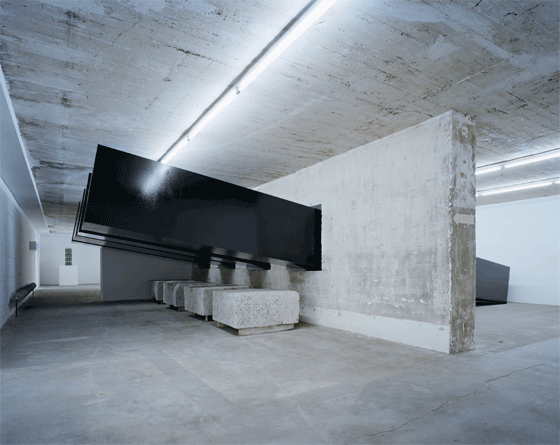
Christian Boros Collection, Berlin: Santiago Serra. Construction and installation of four tar-coated forms, (2002). 800 x 50 x 50 cm, organized in two rooms. © Noshe.
R. J. Preece: Corporate art collections can sometimes face challenges in terms of the selection of artwork in relation to the public image of the company to customers. Are you completely freed up from this concern because you are the boss and in the advertising/ communications field?
Christian Boros: First of all, it should be clear to people that the Boros Collection is a private collection, not a corporate one. Also, the Collection is not a "business tool" but my very private pleasure that I want to share with many people. This is how I view it and sharing my interest in art is important to me.
R.J. Preece: What does the collection in the bunker now mean to you personally?
Christian Boros: It is a good thing that I’m a little crazy. I saw no problem in buying the bunker. This building is a wonderful example of how you can create something new with old things through a new spirit. A new spirit without targets. I am in a fortunate position: except in one instance, every artist whose work I collect is still alive. And they look forward to hanging their work in my museum. There is no company or a curator that imposes their program onto the collection. The artists are their own curators. Art gives my life inspiration and energy. I want to share this experience with other people. This is a very personal, emotional experience. Therefore the bunker is the perfect location: there’s no thermal insulation, no air conditioning, no café and no museum shop. It is more like a rough experimental space. I do not want people jogging through the art site or drinking coffee. I want people to be confronted with the art. I think art shouldn’t be an "event" or entertainment, something a lot of people forget.
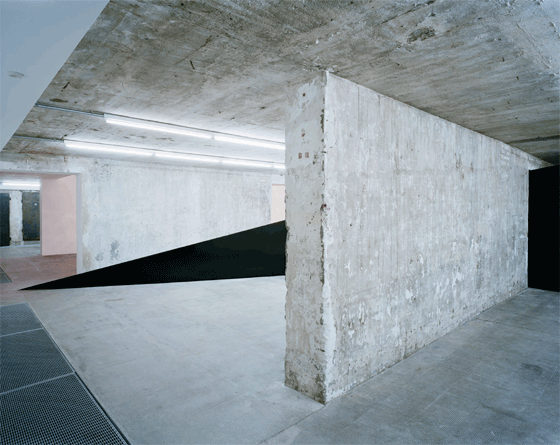
Christian Boros Collection, Berlin: Monika Sosnowska. Untitled (installation view of black non-objective form), (2005). © Noshe.
R. J. Preece: Why did you decide to open the collection to public viewing?
Christian Boros: As mentioned, I want to share my experience with other people. And the site can be one more element here in Berlin that engages itself for the presentation of contemporary art. Art is produced here but is not shown here enough. Visitors are charged for tours of the collection. This money that we collect is used to provide income for our guides. They are great young people, with much energy and passion for art.
R. J. Preece: Lastly, I’d like to ask you again about your quote, "I collect art that I don’t understand." While this message summarizes your approach, it’s also an effective slogan that has figured prominently in the press coverage on the Boros Collection. Did you know this would happen when you approved and released the message?
Christian Boros: Yes. And what is the problem with this quote? It is the best message to summarize my approach. The art that I immediately understand, I usually find boring.
